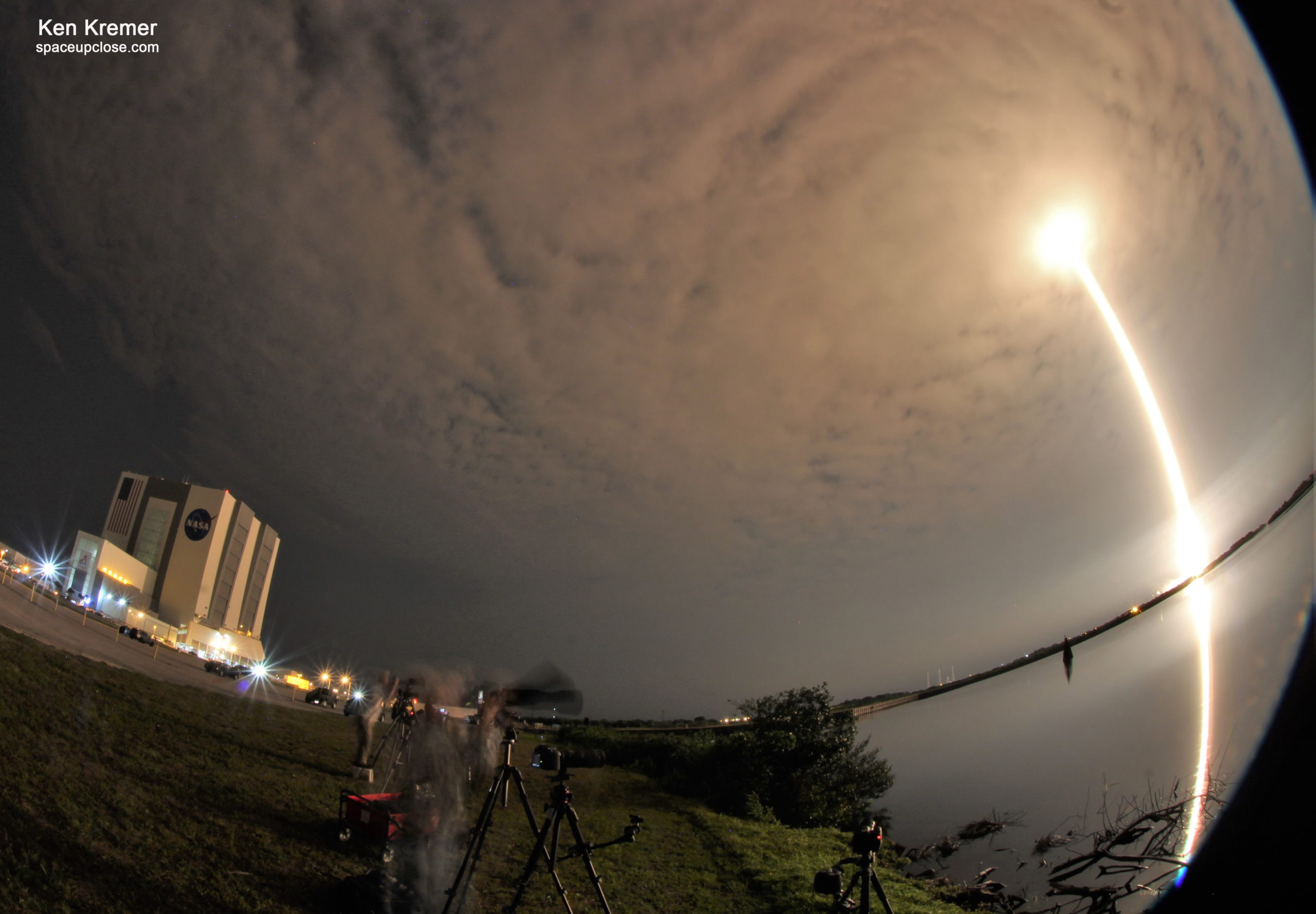
For SpaceUpClose.com & RocketSTEM
KENNEDY SPACE CENTER, FL – A veteran SpaceX Falcon 9 rocket delivered the next batch of Starlink broadband internet satellites to LEO from NSA’s Kennedy Space Center (KSC) in Florida during a beautiful predawn launch Friday, May 6.
As witnessed from our viewing location at the KSC Press site the Falcon 9 quickly disappeared in less than 20 seconds into completely overcast skies over the Florida Space Coast but afforded a very loud experience with the sound waves partially reverberating back down from the thick low clouds to ground viewing.
Nevertheless. the scene was spectacular and briefly turned night into day – see our lead photo of the SpaceX Falcon 9 streak to orbit on the mission designated Starlink 4-17.
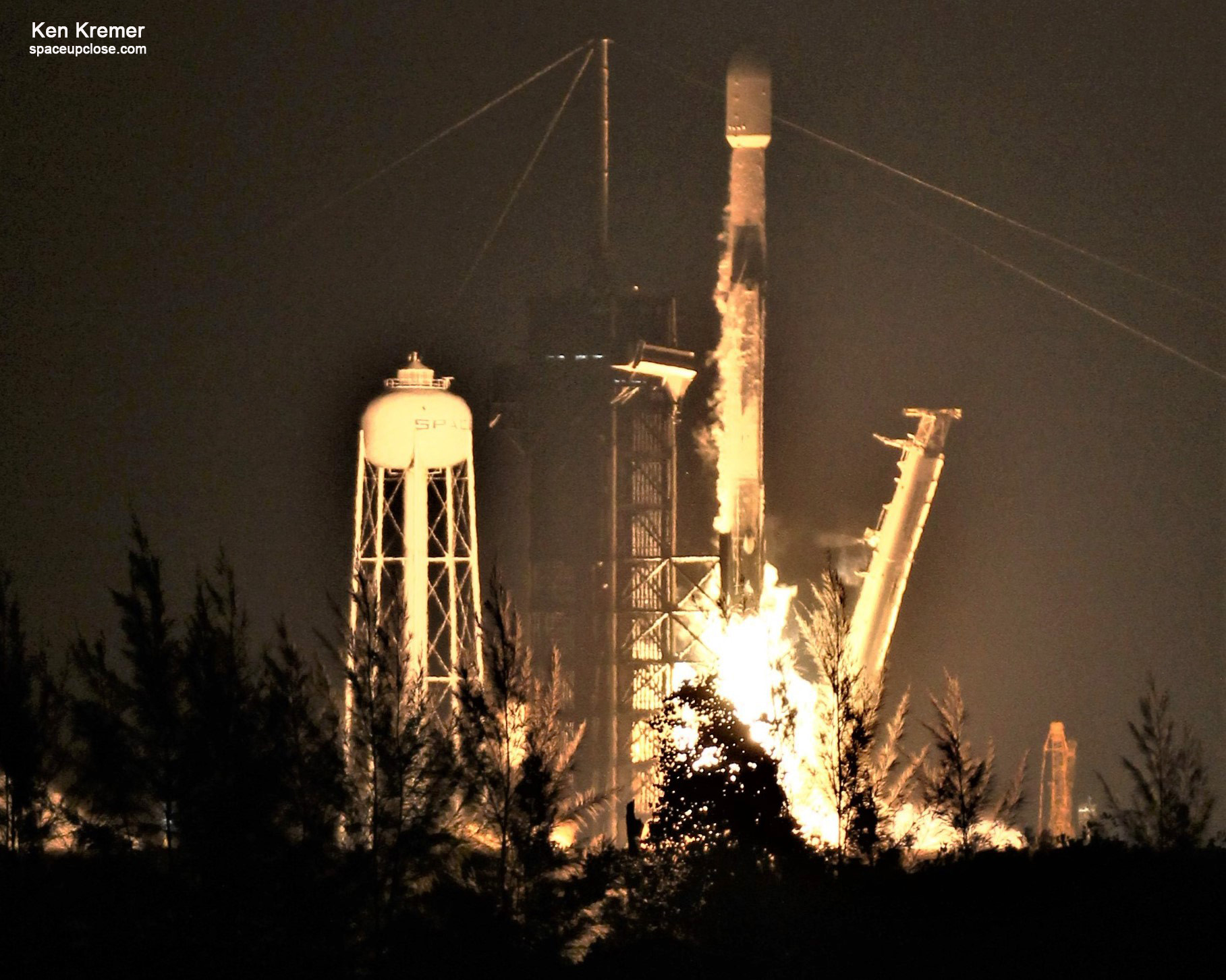
However, viewers elsewhere ringing the pad just a few miles further north and south witnessed much clearer views as the Falcon 9 punched through the low clouds and back out on the path to orbit and some even witnessed the fantastic ‘space jellyfish’ effect that can sometimes be seen within about an hour before dawn or after sunset as the Falcon 9 rises into daylight
Launch of the 229-foot tall (70 meter) two stage Falcon 9 took place Friday, May 6 at 5:20 a.m. EST (0920 GMT) from Launch Complex 39A (LC-39A) at the Kennedy Space Center in Florida, carrying a payload of 53 Starlink broad band high speed internet satellites to low Earth orbit on the Starlink 4-17 mission – during an instantaneous launch window.
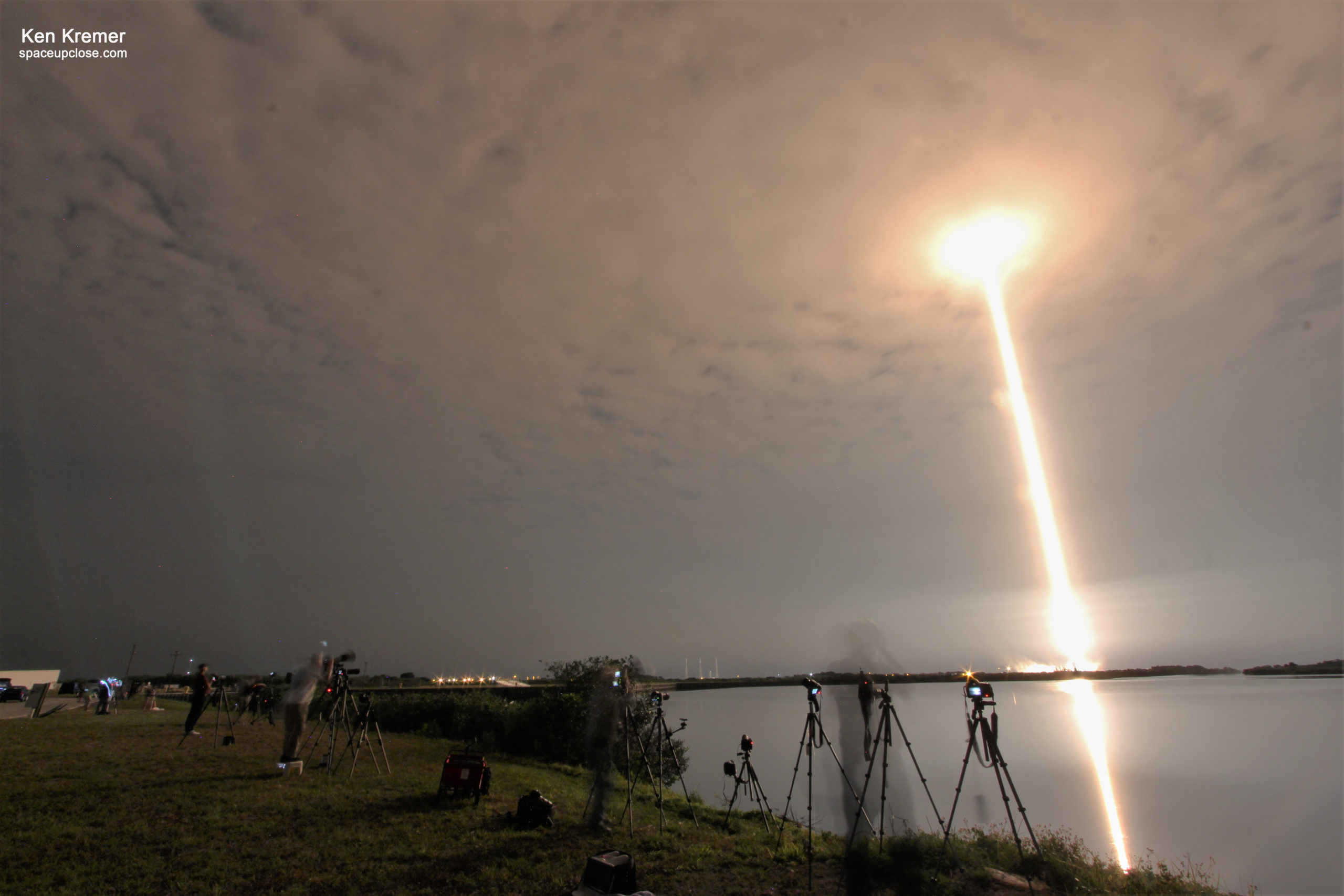
The Starlink 4-17 launch also came just 5 hours after the splashdown of the SpaceX Crew Dragon with the Crew-3 astronaut quartet from the US and Germany returning from a 6 month science expedition aboard the International Space Station (ISS) – continuing an incredible cadence of launches and landings by SpaceX.
Falcon 9 flew aloft flawlessly and beautifully away on a northeasterly trajectory.
Eight and a half minutes later following stage separation at 2 minutes 35 seconds the ‘flight-proven’ Falcon 9 B1058.12 nailed the precision guided touchdown on the ‘A Shortfall of Gravitas (ASOG) drone ship prepositioned some 400 miles (640 km) off the coast of the Carolina’s in the Atlantic Ocean.
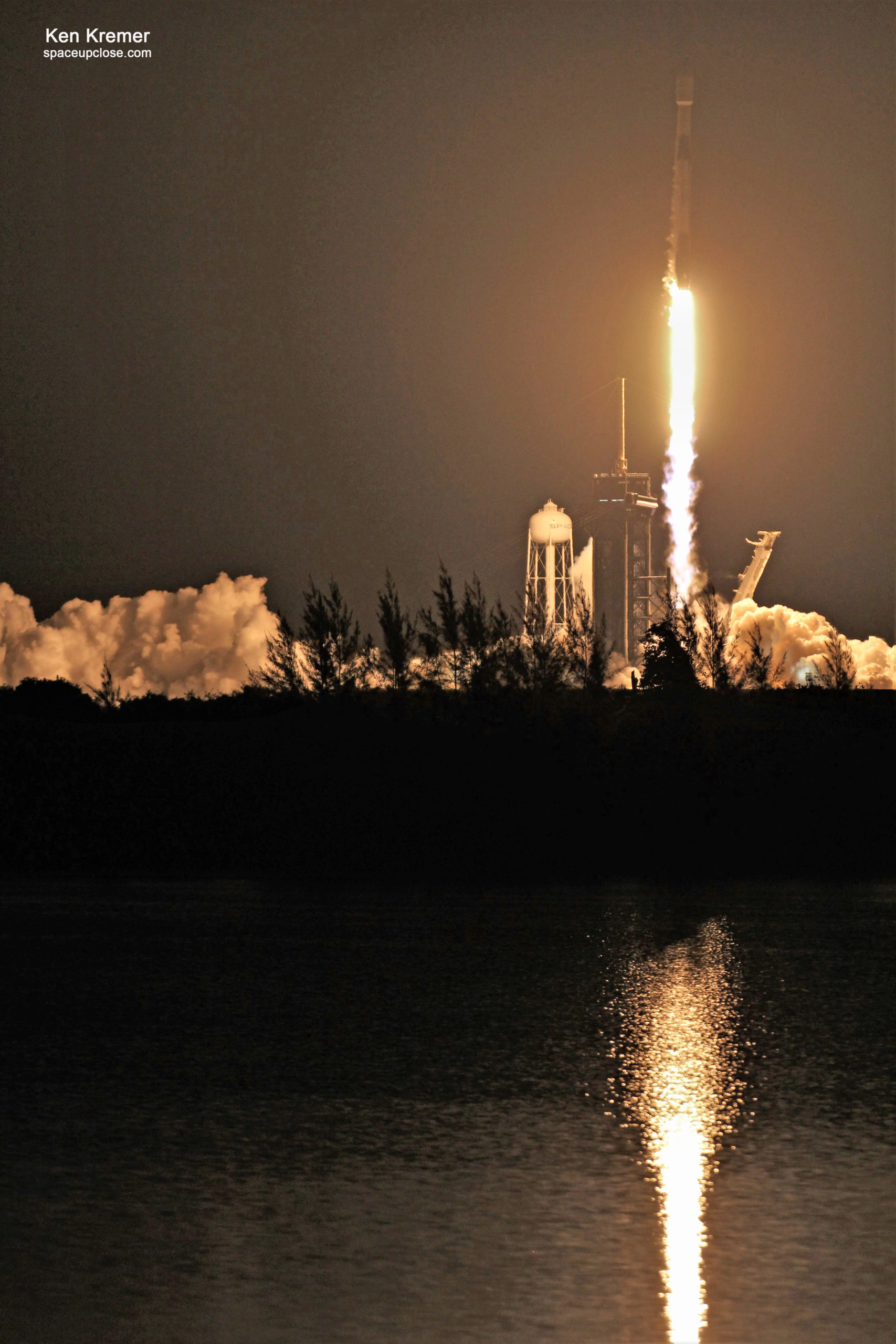
The Starlink 4-17 blastoff of 1st stage B1058 counts as its 12th flight to space & back – tying two other for the distinction of fleet leader.
Overall this marked the 44th SpaceX mission dedicated to Starlink launches and the 18th Falcon 9 launch this year – as well as being the 152nd Falcon 9 launch since its debut on June 4, 2010.
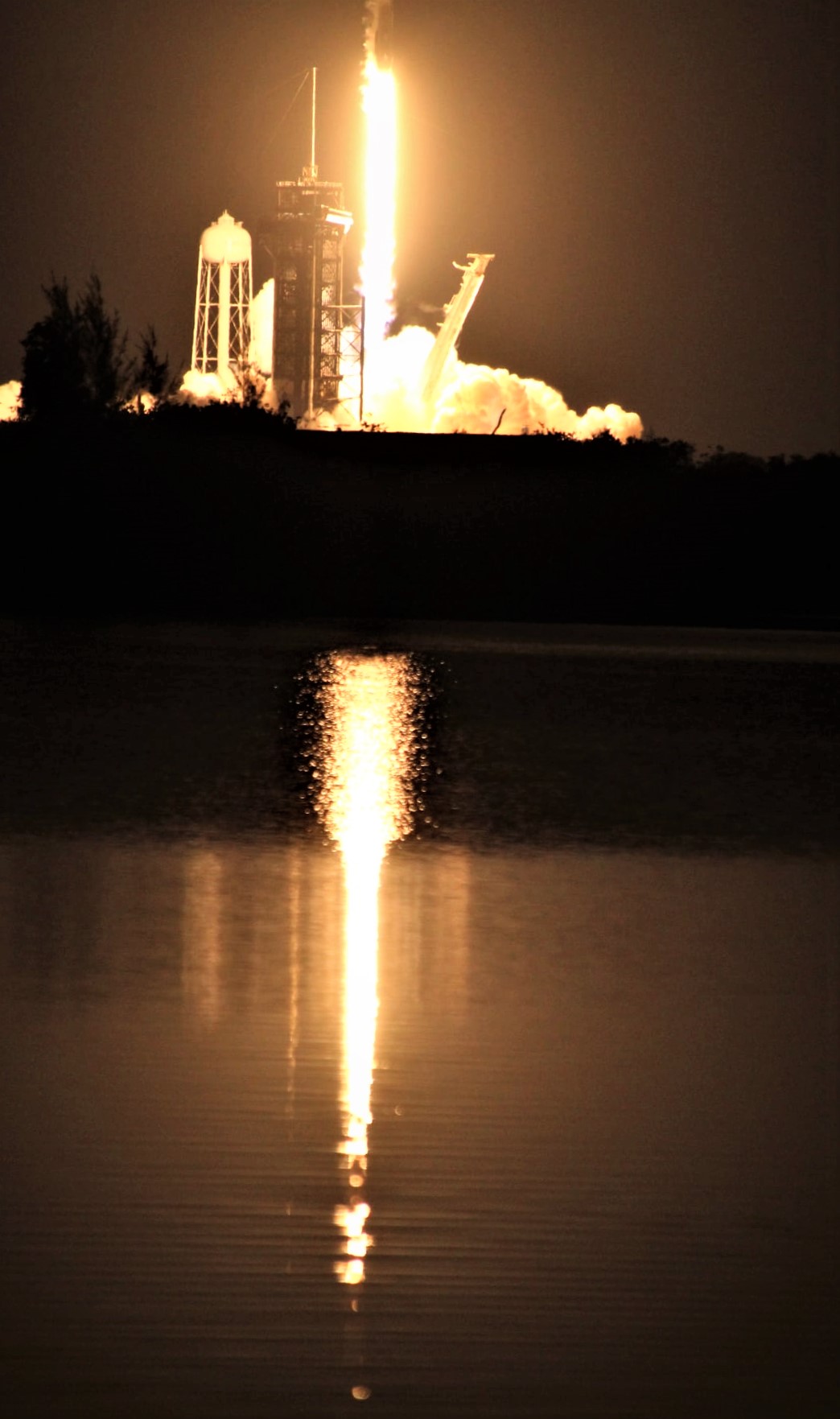
The first stage booster supporting this mission B1058 previously launched Crew Demo-2, ANASIS-II, CRS-21, Transporter-1, Transporter-3, and six Starlink missions.
Most recently B1058 flew on the Starlink 4-8 mission on 21 Feb 2022.
Friday’s liftoff also marked the 1st SpaceX Falcon 9 launch of May and will be followed by several more.
It follows two launches last week of NASA ESA Crew-4 and another Starlink.
It also follows a record breaking six Falcon 9 launches just in the month of April.
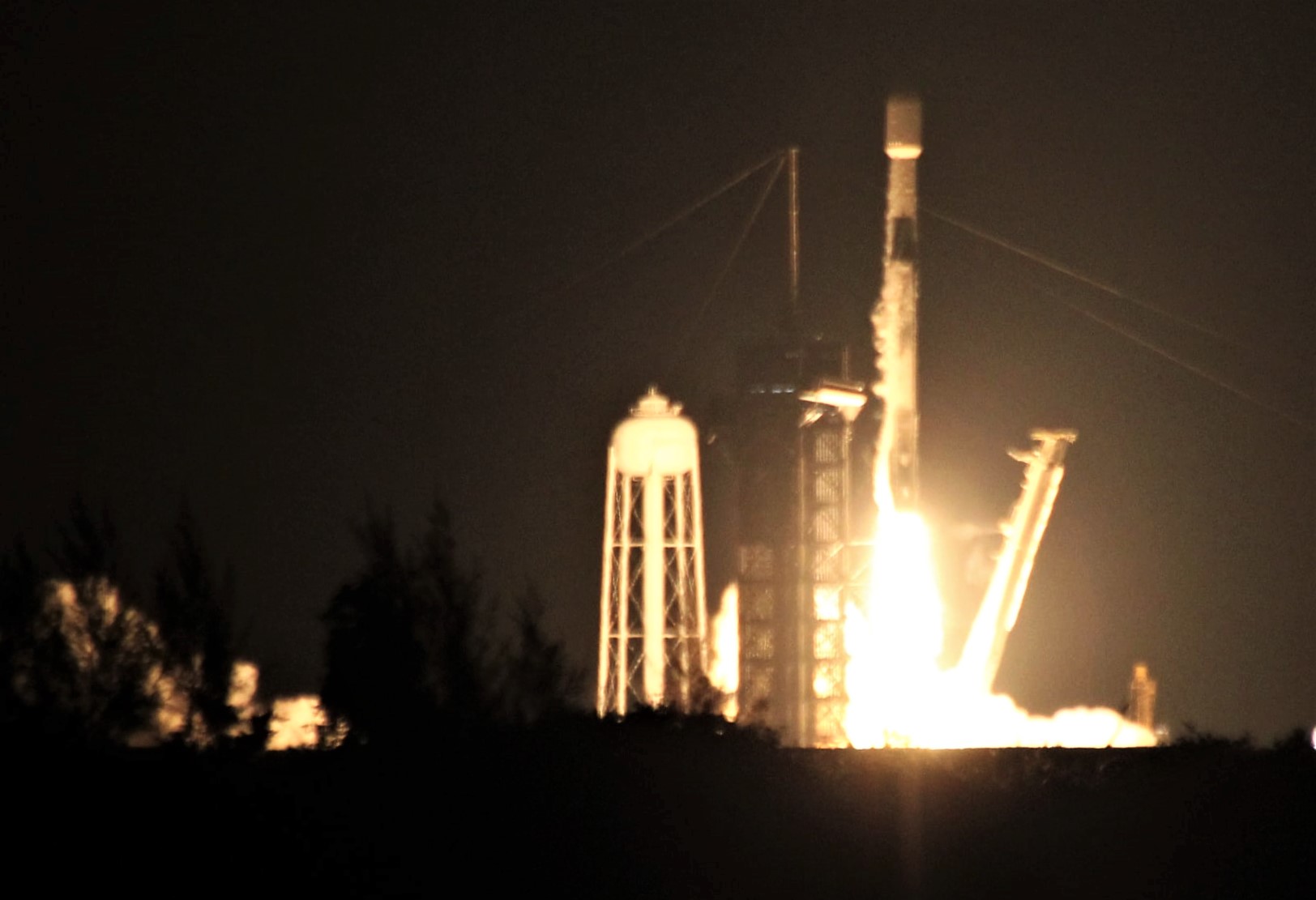
Thus this phrenetic launch pace keeps SpaceX on track to achieve the record breaking goal of 50 to 60 launches this year of 2022 – the stated goal announced by SpaceX CEO Elon Musk.
This approximate one (or more) per week launch rate would about double the already record breaking achievement of 31 Falcon 9 launches set last year in 2021
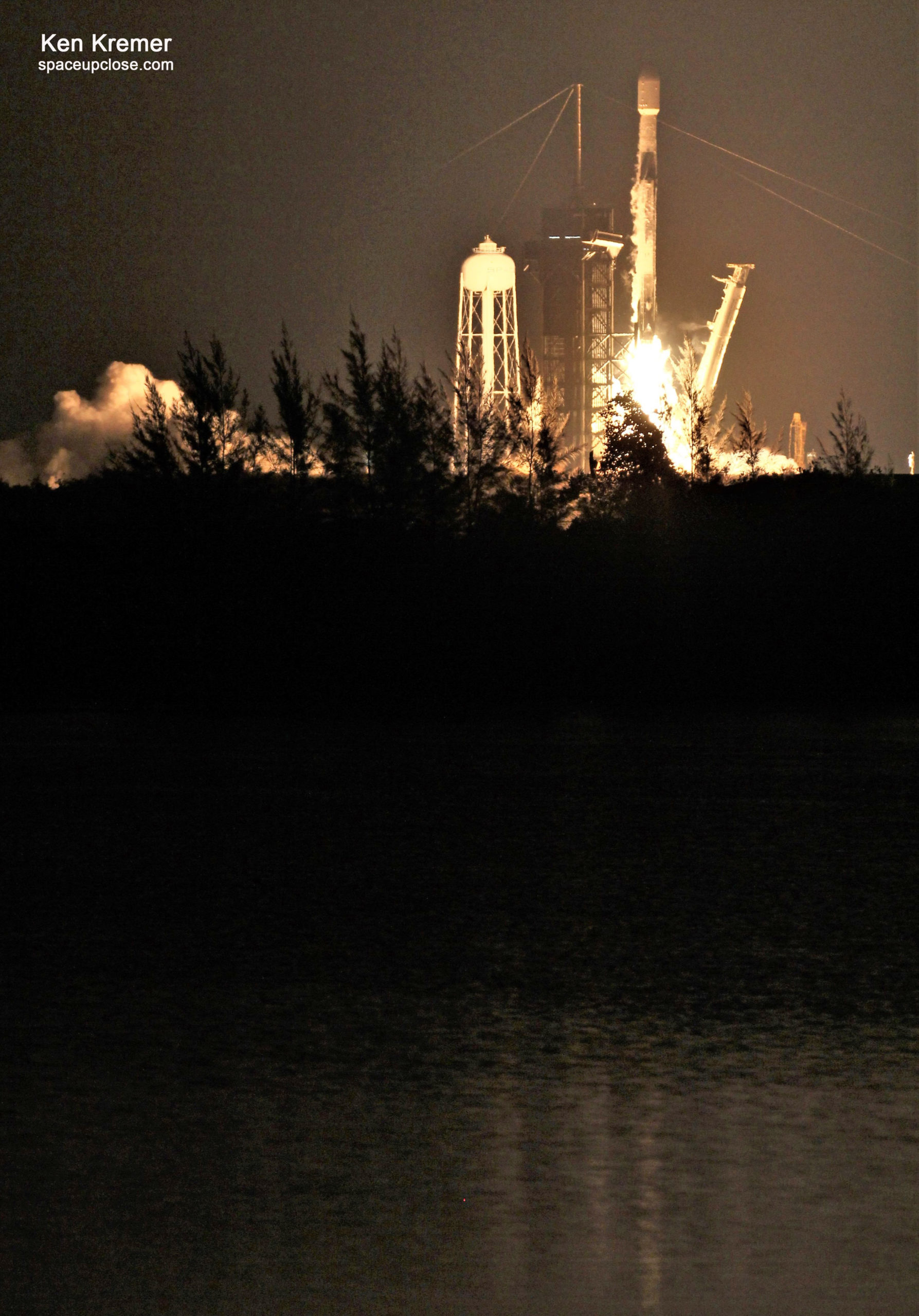
Enjoy our photos of the Starlink 4-17 mission taken by the Space UpClose team of Ken Kremer and Jean Wright.
This Starlink 4-17 launch also closely follows by just one week the prior Starlink 4-16 launch on April 29.

The flat paneled solar powered Starlink satellites were all deployed as planned nearly an hour after launch at 54 minutes 30 seconds into a near-circular orbit ranging in altitude between 189 miles and 197 miles (304 by 317 kilometers), at an orbital inclination of 53.2 degrees to the equator.
Deployment of 53 Starlink satellites confirmed
— SpaceX (@SpaceX) May 6, 2022
The goal of SpaceX’s Starlink constellation is to provide low cost, high-speed, low-latency broadband connectivity around the world.
SpaceX is targeting an initial constellation of about 4,400 satellites authorized by the FCC that could grow to literally 30,000 or more over time.
The roughly quarter ton solar powered Starlink satellites will use their krypton fueled ion thrusters to reach their operational altitude of about 335 miles (540 kilometers).
The payload comprises 53 upgraded Starlink internet communications satellites manufactured by SpaceX in their Redmond, Washington production facility – enlarging the existing and burgeoning broadband constellation to over 2400 launched thus far.
This Starlink 4-17 mission counts as the 44th mission dedicated to launching Starlink internet satellites and raises the total number of Starlink satellites launched to 2,494 Starlink satellites to date. including prototypes and test versions.
A running tally is maintained by astrophysicist Jonathan McDowell of Harvard
https://planet4589.org/space/stats/star/starstats.html
Approximately 2247 of them remain in orbit and 2216 are still working and about 1745 are actually operational
The prior SpaceX launches took place on the NASA ESA Crew-4 mission to the ISS on April 27 and Starlink 4-16 on April 29 last week.
SpaceX also confirmed the booster B1058 soft landing on ASOG.
Watch this video:
Falcon 9’s first stage has landed on the A Shortfall of Gravitas droneship pic.twitter.com/Yvw0IDTGa1
— SpaceX (@SpaceX) May 6, 2022
Watch Ken’s commentary about Starlink, NASA SLS WDR demo test, NASA Crew-3, Crew 4 and SpaceX AX-1 mission:
Apr 29: WKMG CBS 6 with my commentary about the record setting Falcon 9 turnaround of 21 days since the Axiom-1 launch
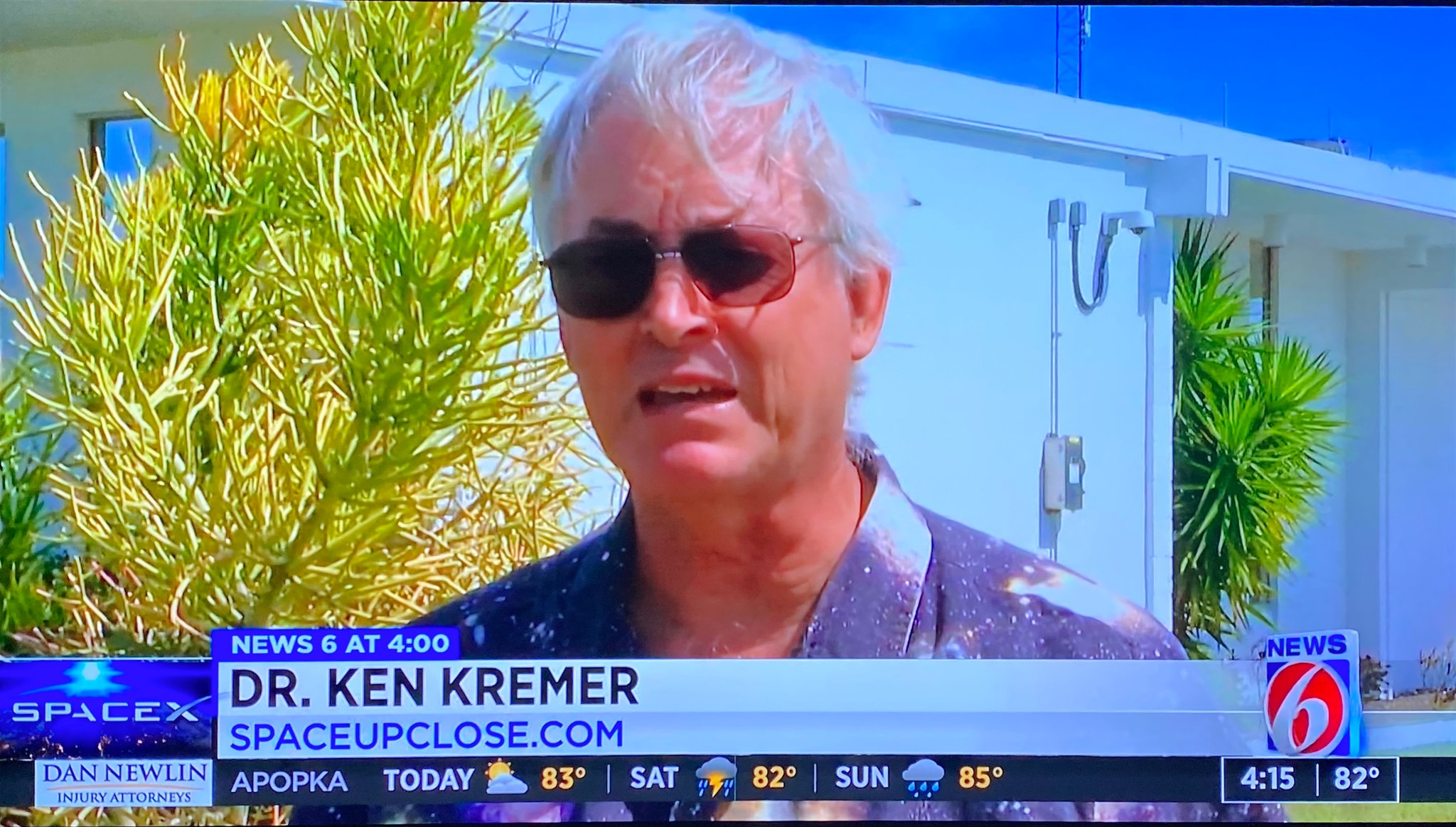
Apr 22: Fox 35 Orlando features my analysis of the busy week ahead in space with weather delayed Earth return of AX-1 crew this weekend, launch of 4 NASA/ESA Crew-4 astronauts on SpaceX Crew Dragon NET Apr 26 & rollback of NASA SLS to VAB for repairs
https://www.fox35orlando.com/video/1060937
Apr 20: WFTV ABC News Orlando features my commentary about the SpaceX static fire and impact of weather induced delays to departure of Ax-1 and launch of Crew-4.
Apr 15/16 & Apr 12/13: WFTV ABC News Orlando and WKMG CBS 6 Orlando featured my comments about NASA SLS WDR wet dress rehearsal countdown and fueling demo test and human launches to ISS:
Apr 6: WFTV ABC 9 Orlando featured my comments about 1st fully private astronaut launch to ISS by SpaceX on AX-1 mission:https://www.wftv.com/news/local/brevard-county/first-all-private-astronaut-mission-iss-set-liftoff-kennedy-space-center-this-week/FYE5QAT735BA7G42O6IVCJGB4Q/
Apr 4 & 5: WFTV ABC News Orlando and Fox 35 Orlando featured my comments about NASA SLS WDR wet dress rehearsal countdown and fueling demo test and human launches to ISS
https://www.fox35orlando.com/news/nasa-resumes-artemis-i-wet-dress-rehearsal-countdown
Watch Ken’s continuing reports about SpaceX Crew and Cargo Dragons, SpaceX Axiom-1, Artemis, SLS, Orion and NASA missions, JWST, IXPE, DART, Lucy Asteroid mission, GOES, SpaceX Starlink, Commercial Crew and Starliner and Crew Dragon, Blue Origin and Space Tourism, and onsite for live reporting of upcoming and recent SpaceX and ULA launches including Crew 1 & 2 & 3 & 4, ISS, Solar Orbiter, Mars 2020 Perseverance and Curiosity rovers, NRO spysats and national security missions and more at the Kennedy Space Center and Cape Canaveral Space Force Station.
Stay tuned here for Ken’s continuing Earth and Planetary science and human spaceflight news: www.kenkremer.com –www.spaceupclose.com – twitter @ken_kremer – email: ken at kenkremer.com
Dr. Kremer is a research scientist and journalist based in the KSC area, active in outreach and interviewed regularly on TV and radio about space topics.
………….
Ken’s photos are for sale and he is available for lectures and outreach events
Please consider supporting Ken’s work by purchasing his photos and/or donating at Patreon:
https://www.patreon.com/kenkremer
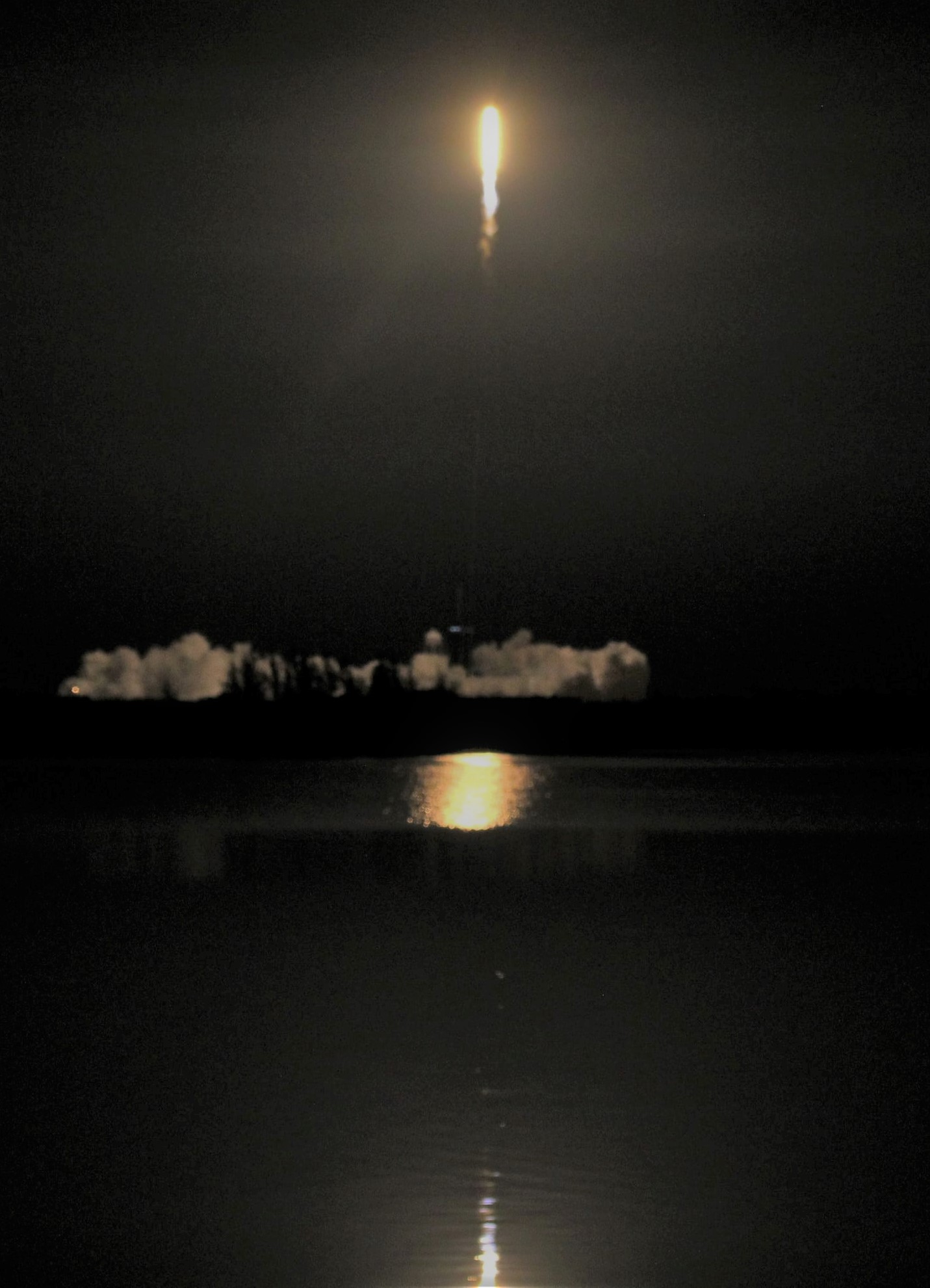
x



